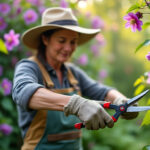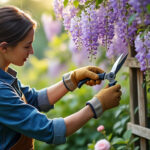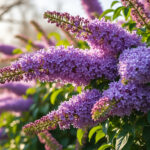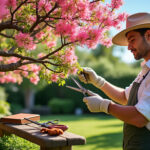Understanding the intricacies of pruning mophead hydrangeas can significantly enhance their vibrancy and flower production. This type of hydrangea, known scientifically as Hydrangea macrophylla, is adored for its lush, colorful, pom-pom blooms. It is, however, essential to grasp the nuances of the plant’s growth pattern to achieve optimal results. Timing is everything when it comes to pruning these stunning features of any garden. An incorrect pruning schedule can result in a landscape devoid of the lush flowers one may expect.
- Understanding the Best Timing
- Signs Indicating It’s Time to Prune
- Techniques for Effective Pruning
- Factors to Consider During Pruning
- Common Mistakes to Avoid
Understanding the Best Timing for Pruning Mophead Hydrangeas
The ideal timing for pruning mophead hydrangeas is generally in late winter to early spring, just before the new growth begins to emerge. This period is crucial as it allows gardeners to effectively remove any dead, damaged, or diseased wood from the previous year. Pruning at this stage stimulates new growth and ensures that the plant’s energy is directed towards producing vibrant blooms for the upcoming season.
Just as importantly, avoiding fall pruning is highly recommended. If carried out during this time, the hydrangeas will be more vulnerable to winter frost and harsh weather conditions. For instance, cold snaps can damage the plant at a critical juncture, leading to stunted growth or a reduced bloom count in the spring.
The Importance of Old Wood for Flowering
Mophead hydrangeas primarily bloom on old wood, which means that the flower buds form on stems that have matured from the previous season’s growth. Thus, pruning them too late can inadvertently remove these buds and prevent flowering. This is particularly relevant for homeowners aiming to have a vibrant landscape come summertime. Careful observation of the plant’s growth cycle is vital for successful gardening.
| Pruning Phase | Recommended Timing | Effect on Blooms |
|---|---|---|
| Late Winter to Early Spring | Before New Growth Starts | Promotes/Vibrant Blooms |
| Fall | After Flowering | Increases Frost Damage |
Signs Indicating It’s Time to Prune Mophead Hydrangeas
Several signs suggest it may be time to reach for those pruning shears. Recognizing these cues ensures that the health of the plant remains intact while also facilitating optimal growth and blooming.
- 🌱 Overgrown Appearance: Variants with unruly branches often require maintenance. A tidy shape can be restored through selective pruning.
- 🌿 Dead or Diseased Branches: Promptly removing these segments boosts the overall health of the plant and stimulates new growth.
- 🤝 Crossing or Rubbing Branches: When branches engage in a tussle, their growth can be hampered. Such branches should be pruned to enhance air circulation.
- 🌼 Sparse Foliage: A lack of leaves may indicate that pruning is necessary for encouraging rejuvenated growth.
- 🚫 No Flowering: If blooms are scarce in the growing season, it is likely time for pruning to stimulate new growth.
Additionally, observing the plant closely reveals various other signs like overcrowding, winter damage, and sparse blooms, all indicating that professional pruning may be beneficial. This proactive approach can significantly enhance the plant’s growing conditions.
When to harvest second early potatoes for the best flavor
Techniques for Effective Pruning of Mophead Hydrangeas
Once the determination to prune has been made, it’s essential to approach the task with care and the right techniques. Employing effective pruning methods ensures the longevity and vibrant health of mophead hydrangeas.
Essential Tools for the Job
Using the right equipment is critical. Invest in quality pruning tools, including sharp bypass pruners for smaller branches. For thicker limbs, loppers may be necessary. Each tool should be well maintained to ensure that cuts are clean, as this aids in quicker healing.
- ✂️ Sharp Bypass Pruners: Ideal for small to medium-sized branches.
- 🦺 Loppers: Necessary for thicker branches that require more power.
- 🔨 Pruning Saw: Best suited for larger cuts.
The 3-Cut Method for Larger Branches
For larger branches that cannot be cut in a single stroke, the 3-cut method is particularly effective. This involves making an undercut first, followed by a top cut. The sequence minimizes tearing and damage to the surrounding area.
| Cut Type | Description | Purpose |
|---|---|---|
| First Cut | Undercut on the branch | Prevents tearing |
| Second Cut | Top Cut to sever the branch | Ensures clean removal |
Factors to Consider During Pruning Mophead Hydrangeas
Understanding various factors impacting soil, potential sunlight exposure, and the age of the plant plays a crucial role in efficient pruning practices. Each consideration influences the subsequent health of mophead hydrangeas.
The Age of the Plant
With younger plants, it is advisable to postpone heavy pruning. Young mopheads require less intense intervention, preserving their natural shape while allowing them to establish a robust root system. On the other hand, older plants often require more extensive pruning to maintain their vigor and vitality.
Soil and Sunlight Conditions
A well-drained site with adequate sunlight promotes healthy growth. Thus, ensuring that mophead hydrangeas receive at least six hours of sunlight daily is conducive to robust flowering.
- ☀️ Ideal Sunlight: At least 6 hours a day.
- 🌍 Well-Drained Soil: Essential for optimal growth.
- 👶 Young plants should not be stressed too much.
Common Mistakes to Avoid When Pruning Mophead Hydrangeas
Even the most seasoned gardeners can fall prey to common mistakes when pruning mophead hydrangeas. Understanding these pitfalls ensures better outcomes when tending to these beloved plants.
Pruning at the Wrong Time
One of the significant errors is pruning at the wrong time of the season, which may lead to the loss of flower buds for the upcoming year. Identifying the exact timing for pruning is crucial to avoid this setback.
Excessive Pruning
Removing an excessive amount of growth can lead to leggy plants and diminished flowering. Strive for a balance that only alters the structure of the plant rather than cutting it back too dramatically.
Neglecting Plant Health
Failing to assess the general health of the hydrangeas before engaging in heavy pruning can be detrimental. Prioritize the well-being of the plant by ensuring any necessary treatments for disease are administered before pruning.
- 🛑 Avoid cutting old wood.
- 🗓️ Know the right season for pruning.
- 👀 Maintain plant health before pruning.
FAQ About Pruning Mophead Hydrangeas
1. When is the best time to prune mophead hydrangeas?
The best time to prune mophead hydrangeas is late winter to early spring, just before new growth starts.
2. Can I prune them in the fall?
Fall pruning is generally discouraged, as it leaves the plants vulnerable to winter frost damage.
3. What should I do if I accidentally prune too much?
If too much has been pruned, focus on allowing the plant to recover and avoid future heavy pruning for at least a year.
4. Do all hydrangeas bloom on old wood?
Not all hydrangeas bloom on old wood, but mophead hydrangeas primarily do, making timing of the utmost importance when pruning.
5. Can improper pruning affect flowering?
Yes, improper pruning can significantly affect flowering potential due to the loss of buds that were set in the previous growth cycle.

















